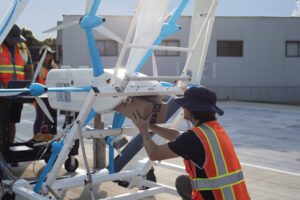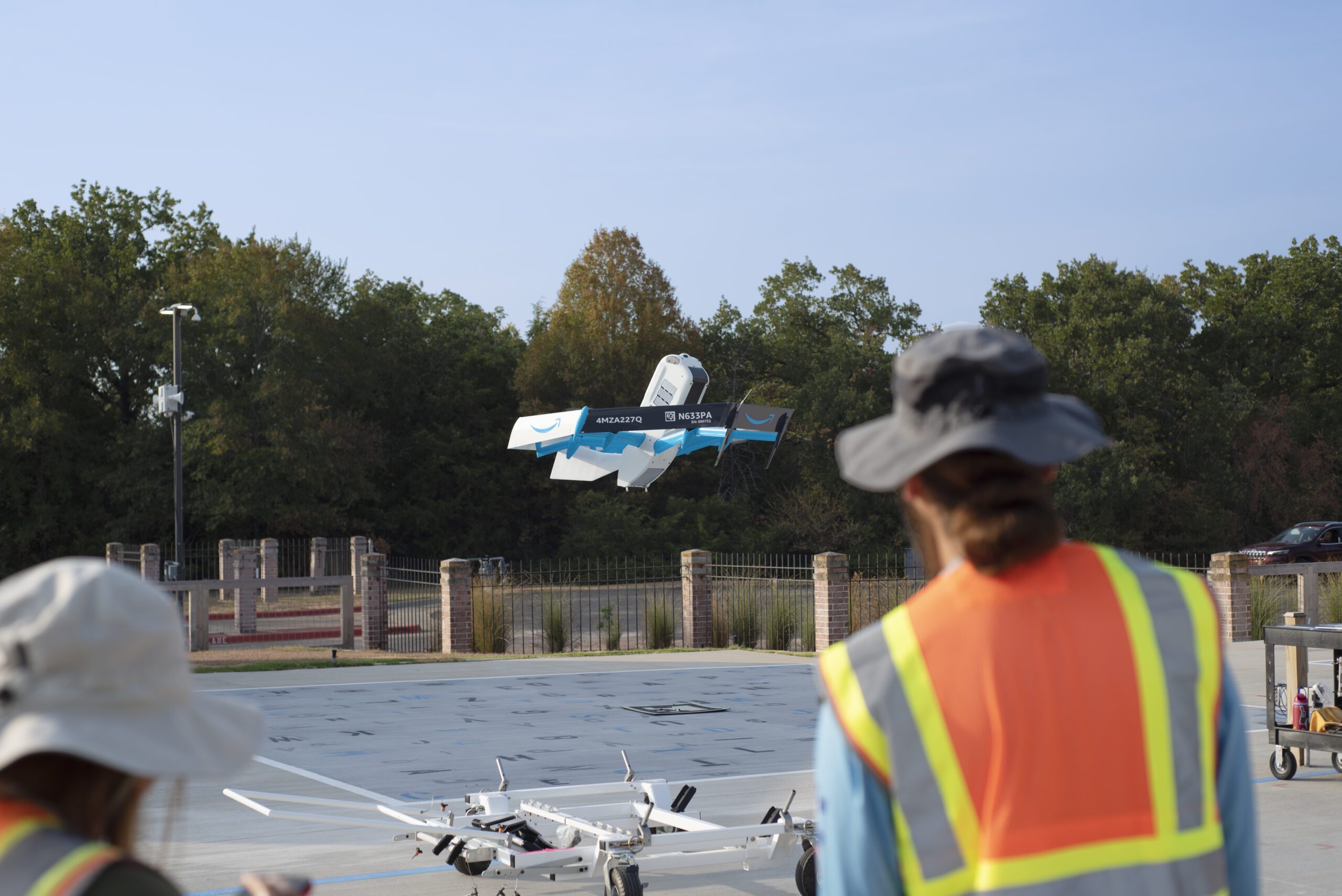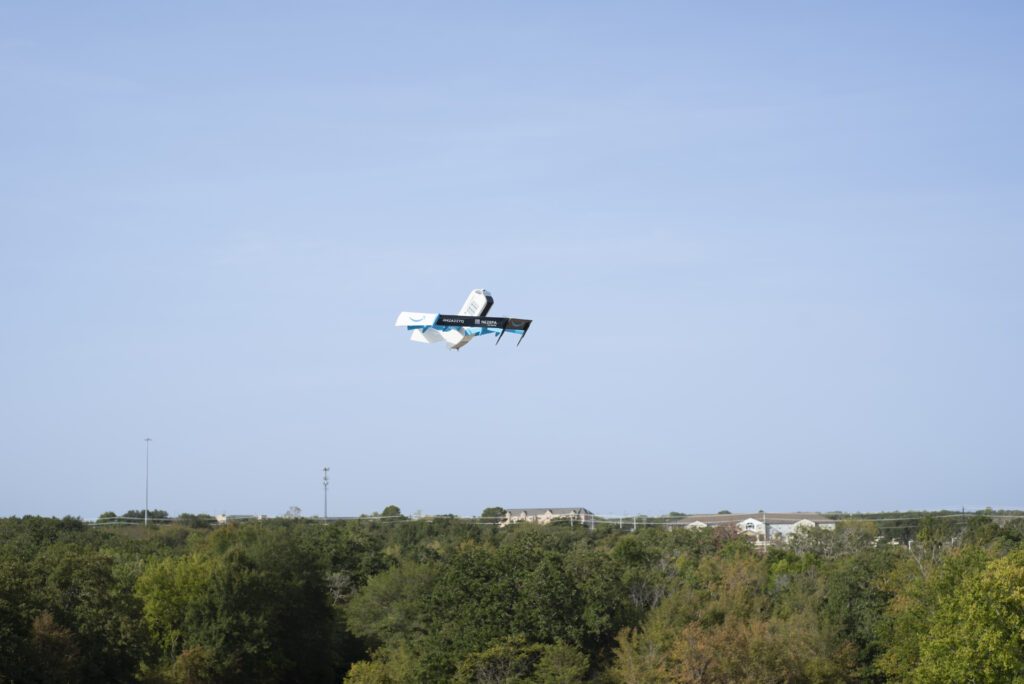
By DRONELIFE Feature Editor Jim Magill
Amazon has expanded its drone delivery service in College Station, Texas to include the delivery of prescription drugs.
The company, which chose the Texas city as one of two sites to initiate its first drone delivery pilot program last year, said customers in College Station can now get prescription medications dropped outside their door through its Amazon Pharmacy subsidiary.
Under the new program, College Station residents who are eligible Amazon Pharmacy customers can select “free drone delivery in less than 60 minutes” at checkout, giving them access to drone delivery of more than 500 medications that treat common conditions, such as flu, asthma and pneumonia. A pharmacist will oversee the process to ensure that the proper medications are loaded aboard the drone for transport.
Amazon’s employs the six-propeller MK30 hybrid VTOL drone, designed and built by Amazon Prime Air, capable of taking off and landing vertically like a helicopter, and using wing-borne flight when moving through the air.
“This capability, VTOL, allows us to safely place the package where our customers want them, while minimizing our noise signature and keeping us at a safe distance from obstacles, people and pets in the delivery location,” Amazon spokeswoman Zoe Hoffman said.

Amazon’s drones fly autonomously at an altitude of between about 130 feet to close to 400 feet to ensure that the UAVs are unlikely to encounter any obstacles. The drones’ built-in sense-and-avoid technology uses sensors and cameras to navigate around objects.
The vehicle’s airborne cameras feed into a neural network trained to identify objects in the drone’s path. On arrival at the customer’s home, the drone slowly and safely lowers itself above a delivery marker placed on the ground by the customer, Amazon said.
“Computer vision will detect any structures or objects protruding from the ground—including people and animals—and check if they are interfering with the descent path. When the delivery zone is clear, the drone releases the package, rises back up to its flight altitude, and returns to the delivery center. Customers pick up packages without any interaction with the drone,” the company said.
Since launching its drone delivery service last December, the company has made several hundred drone deliveries of common household items to College Station customers.
“Our drones fly over traffic, eliminating the excess time a customer’s package might spend in transit on the road,” said Calsee Hendrickson, director of product and program management at Prime Air. “That’s the beauty of drone delivery, and medications were the first thing our customers said they also want delivered quickly via drone. Speed and convenience top the wish list for health purchases.”
After almost a decade of development, Amazon Prime Air launched its first pilot programs for drone delivery in College Station and Lockeford, California last year. Hoffman said the company has received a positive response from customers in both pilot test locations.
“Feedback from customers in California and Texas has been great; and they are really happy with the service,” she said.
On October 17, Amazon announced that it plans to expand it drone delivery to a third U.S. state as well as to Italy and the UK by the end of next year.
When anticipating a drone delivery, residents of single-family homes must ensure that a special drone delivery marker is placed in the designated location identified during their yard survey. Drone delivery customers are urged to keep grass in the delivery area trimmed and keep all people, pets and objects at least 17 feet away from the delivery marker when expecting a drone delivery.
Amazon customers living in an apartment building deemed eligible for drone delivery use a gated drone delivery area, which has been specially designated for their building, when picking up their drone-delivered products. Once they have received the notification of the delivery of their purchased item, these customers use a previously provided gate access code to enter the fenced area to retrieve their package.
Amazon Pharmacy customers in College Station have the option to select drone delivery for their medications during the check-out process. If an item is drone-eligible, customers will see a “Delivery by Drone” option that promises delivery within 60 minutes. The Amazon Pharmacy had worked in conjunction with the Texas Board of Pharmacy to ensure that it met all regulatory standards to allow it to conduct drone deliveries.
Last November, Amazon Prime Air announced the launch of its next-generation delivery drone: the MK30. Due to come into service next year, this drone will be lighter and smaller than the MK27-2, the drone currently making deliveries in Lockeford and College Station. The MK30’s increased range, expanded temperature tolerance, safety-critical features, and new capability to fly in light rain will enable customers to choose the drone delivery option more often, the company said.
Read more:
- Amazon Drone Delivery Layoffs: Prime Air Hit Among 18,000 Job Cuts
- Amazon Drone Delivery Begins in Two US Communities: How Does it Work?
- Newest Model of Amazon Delivery Drone Revealed
- Amazon Drone Delivery Video Reveals Delivery Mode and More
- Amazon Drone Delivery: A Brief History of the Patents, Problems and Progress from the DRONELIFE Archives
Miriam McNabb is the Editor-in-Chief of DRONELIFE and CEO of JobForDrones, a professional drone services marketplace, and a fascinated observer of the emerging drone industry and the regulatory environment for drones. Miriam has penned over 3,000 articles focused on the commercial drone space and is an international speaker and recognized figure in the industry. Miriam has a degree from the University of Chicago and over 20 years of experience in high tech sales and marketing for new technologies.
For drone industry consulting or writing, Email Miriam.
TWITTER:@spaldingbarker
Subscribe to DroneLife here.
